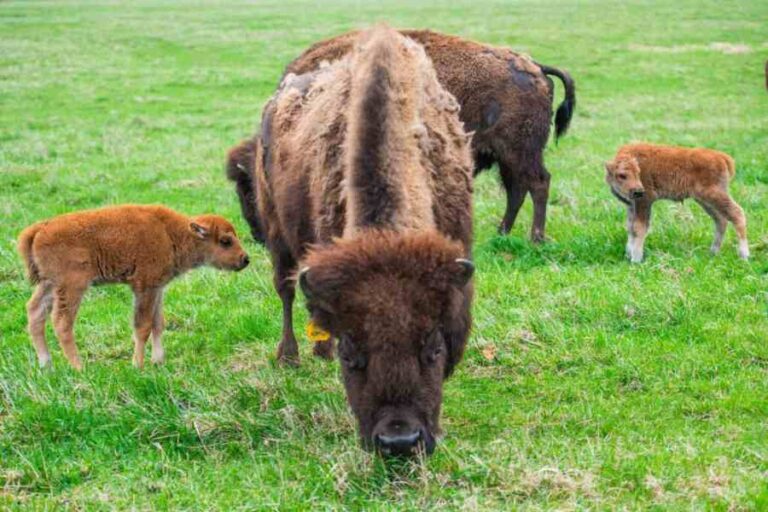Fermilab, a world-renowned particle physics research facility located in Batavia, Illinois, is famous for its cutting-edge experiments and high-energy physics research. But there’s another side to this scientific powerhouse: the bison that roam freely across its sprawling prairie landscape. These majestic creatures are a symbol of the American wilderness, and every year, the birth of new calves marks a significant moment in the natural rhythm of Fermilab’s ecosystem.
This year, Fermilab is celebrating the birth of its first bison calves of the season, with two calves born on Monday. This marks the beginning of a new generation of bison that will help ensure the future of the herd that has grazed the Fermilab grounds for more than five decades. As part of Fermilab’s ongoing effort to support and preserve the American bison, the herd plays a unique role in both local ecology and research.
The birth of these calves is not just a natural event but also part of a well-planned effort to maintain a genetically diverse and healthy herd. The arrival of the new calves this week is only the beginning, as about 20 more calves are expected to join the herd before the season concludes in June.
The bison herd at Fermilab has become a beloved symbol of the prairie ecosystem. Over the years, the herd has grown and evolved, now consisting of 23 bison cows, two bulls, and three yearlings from last year. Fermilab takes great care to ensure that the bison remain genetically diverse, rotating the bulls every five to seven years to avoid inbreeding and to preserve the full-blooded status of the herd. This attention to genetic health is essential to keeping the bison robust and adaptable to their environment.
In fact, a 2015 genetic study confirmed that the bison at Fermilab had few, if any, cattle genes, ensuring that the herd remains true to its wild, American bison roots. This commitment to maintaining a pure herd of bison is part of Fermilab’s broader environmental stewardship goals, as the facility works to promote biodiversity and support the health of local wildlife.
When bison calves are born, they arrive with a striking cinnamon-colored coat, a characteristic feature that sets them apart from the rest of the herd. These newborns are typically between 40 to 70 pounds in weight, but they grow rapidly. Within six months, bison calves can weigh between 300 to 350 pounds as they transition to their adult brown coats. As they mature, they’ll begin to take on the rugged and powerful appearance that has made bison one of America’s most iconic species.
The herd’s calves are born in the spring, during the calving season that typically stretches from March through June. However, as in past years, there have been occasional outliers, with calves being born as late as September, like one of last year’s latecomers. Despite the unpredictability of the calving season, Fermilab’s careful monitoring and management help ensure that the bison thrive and contribute to the ecological balance of the prairielands.
The presence of bison at Fermilab is about more than just preserving a species; it is also about maintaining the health of the land itself. Bison are considered a keystone species in prairie ecosystems, meaning their grazing habits help maintain the diversity of plant life in the area. As they move across the landscape, bison create natural clearings in the grass, allowing for a more diverse array of plants to grow. Their waste provides valuable nutrients for the soil, supporting the health of other wildlife that depend on the prairies for survival.
Fermilab’s land management team closely monitors the herd and the health of the prairie ecosystem, ensuring that the balance between human activity and wildlife preservation remains intact. The bison help to control the growth of certain plant species, which allows other native plants to flourish. This process, in turn, creates a more diverse habitat for a variety of insects, birds, and smaller mammals that call Fermilab’s grounds home.
While Fermilab is known for its groundbreaking scientific research, it’s also a place where the public can get up close to nature and witness the beauty of these majestic creatures. Fermilab’s outdoor public areas are open daily from dawn until dusk, offering visitors a chance to see the bison in their natural habitat. However, those planning to visit should be mindful of the security requirements at the facility. To enter, visitors must bring Real ID-compliant identification, ensuring a safe and secure experience for everyone.
Whether you’re a science enthusiast visiting Fermilab for its research facilities or simply someone who loves nature and wildlife, the bison herd offers an unforgettable experience. The herd’s role in Fermilab’s ecosystem is a reminder of the deep connection between science, conservation, and the natural world.
As Fermilab’s bison herd continues to grow and thrive, so does its commitment to the preservation of these incredible animals. The new calves born this season are not only a sign of life’s continuity on the prairie but also a symbol of the ongoing conservation efforts that Fermilab holds dear. With about 20 more calves expected to be born this season, the herd is set to continue its legacy of roaming the prairielands for generations to come.
In a world where conservation efforts are increasingly crucial, Fermilab’s bison herd stands as a powerful reminder that scientific research and environmental stewardship can go hand in hand. With every calf born, Fermilab is not just preserving a piece of the past but ensuring the future of this iconic species on the American prairie.
So, the next time you find yourself in Batavia, Illinois, be sure to visit Fermilab and experience the wonder of these awe-inspiring creatures that roam its expansive grounds. And with calving season underway, there’s no better time to witness the birth of a new generation of bison—one that will continue to thrive in the heart of Fermilab’s vibrant natural world.
